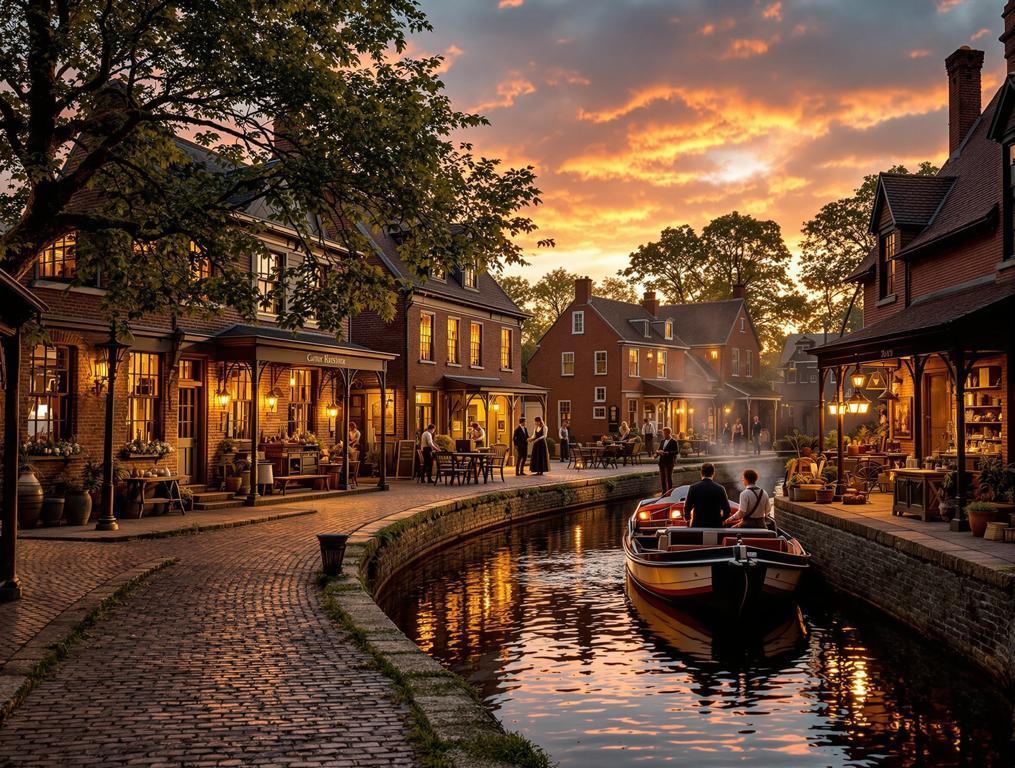I check my watch: 3:47 PM. The historical interpreters in period dress will start closing up shop in precisely 13 minutes. I’ve just parked my rental car in the main lot off Whitewoman Street in Coshocton, Ohio, where only 19% of America’s original canal-era structures still stand. Through the afternoon haze, I glimpse costumed figures moving between restored brick buildings. This isn’t a theme park—it’s Roscoe Village, one of America’s most authentic time capsules, tucked 68 miles east of Columbus.
Rushing toward the village entrance, I feel like I’m racing against both the 4 PM closing and something larger—a vanishing piece of American history that preservation experts warn is increasingly endangered. What makes this different from the dozens of historical villages I’ve visited across America is how it lets you temporarily inhabit, not just observe, life in the 1830s.
Step back in time: Experience the 6-hour daily window into authentic canal life
Roscoe Village opens at 10 AM and closes precisely at 4 PM daily, creating a limited six-hour window to experience this preserved slice of America’s canal era. Unlike many historical attractions that prioritize gift shops over authenticity, Roscoe Village maintains what locals call “temporal integrity.”
Walking the cobblestone paths, I watch a blacksmith hammer red-hot iron into hooks that will actually be used in the village’s restoration work. Each historical building here serves dual purposes—as museum piece and working space—creating an immersion that feels accidental rather than staged.
“You know those Renaissance Faires where everyone’s trying so hard to be old-timey? This isn’t that,” says one visitor exiting the restored bakery with period-appropriate molasses cookies. “Here you just feel like you’ve accidentally slipped through time.”
The canal boat experience provides the centerpiece of this historical immersion. Horse-drawn canal boats operate only three times daily (11 AM, 1 PM, and 3 PM), recreating the primary transportation method that made Coshocton a bustling port before railroads rendered canals obsolete. What makes these rides different from similar attractions is the narration based on actual canal worker diaries rather than sanitized scripts.
19% preservation rate: Why America’s canal history is vanishing faster than experts predicted
Only 19% of America’s canal-era structures remain standing nationwide, according to preservation experts at the Coshocton Visitors Bureau. This percentage drops annually as maintenance costs for these buildings continue rising beyond what many communities can afford.
Unlike America’s industrial heritage sites in Montana that benefit from mining company endowments, canal towns like Coshocton rely primarily on visitor revenue and limited grants. Preservation director Eleanor Wilkins explains that authentic restoration costs have increased 37% since 2020, putting many projects on indefinite hold.
What makes Roscoe Village exceptional is its completeness. While most preserved canal towns maintain only 2-3 buildings, Roscoe Village has preserved 15 original structures within its compact footprint. These buildings don’t just look historical—they function much as they did 190 years ago.
Beyond the tourist experience: How Roscoe Village maintains authenticity unlike Colonial Williamsburg
Unlike Colonial Williamsburg where historical interpreters often recite memorized scripts, Roscoe Village employs local artisans who actually practice historical crafts. The weaver doesn’t just demonstrate—she produces textiles sold in the village. The blacksmith creates functional pieces used throughout the site.
This approach contrasts with Washington’s preserved Victorian towns and former mining towns reinvented as art havens. Rather than replacing historical economies with tourist-centered ones, Roscoe Village maintains its working character.
“I’ve been making candles the same way for 22 years,” explains one demonstrator, hands coated in beeswax. “The difference is I’m actually making them for use, not just for show. That’s what visitors feel when they come here—it’s real.”
Visitor guide: How to maximize your temporal immersion before it’s gone
To fully experience Roscoe Village before preservation challenges potentially limit access, arrive at opening time (10 AM) to secure canal boat tickets, which frequently sell out by noon. Admission costs $14.95 for adults with discounts for seniors and children.
For the most authentic experience, visit on Thursdays when fewer tour groups are present and artisans have more time for demonstrations. The living history tours run at 10:30 AM, 1 PM, and 2:30 PM, with the earliest offering the most personalized experience.
Before leaving Coshocton, explore other chapters of American frontier history at the Johnson-Humrickhouse Museum, which houses the controversial Newark Holy Stones—artifacts that have puzzled historians for generations. Then discover how rural tourism innovations create economic impact by visiting the Three Rivers Wine Trail.
As I reluctantly leave Roscoe Village just before closing time, I understand why preservationists worry about its future. This isn’t just another restored village—it’s one of America’s last authentic connections to its canal-era past. Like the canals themselves, time is carrying us away from these experiences. Some places should be visited before they can’t be visited at all.
